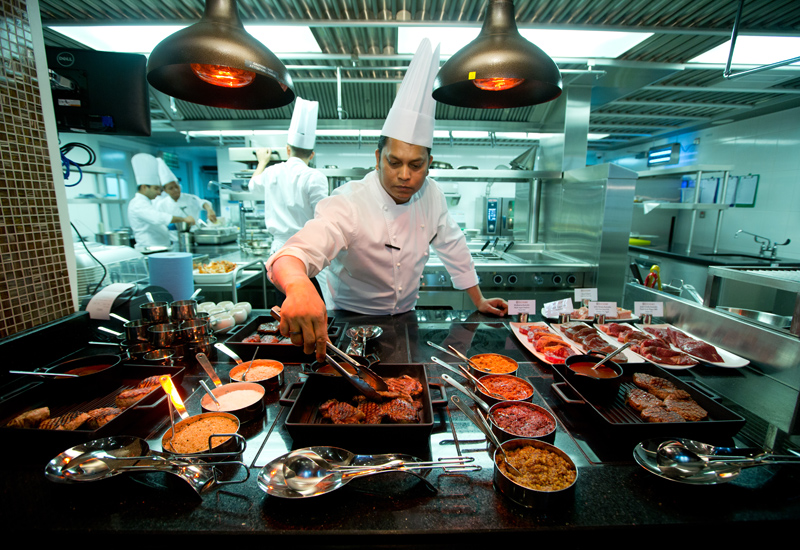Caterer explores how steakhouses manage increasing competition, and work with a variety of cuts and volatile customer palates
Meet the Experts
- Praba Manickam, regional head chef, The Meat Co Kuwait
- Neil David Foster, executive chef, The Rib Room, Jumeirah Zabeel Saray
- John Buenaventura, chef de cuisine, Seafire Steakhouse & Bar
- Nahsen Akgul, sous chef, The Exchange Grill
Would you say steaks are popular in this region?
Praba Manickam, regional head chef, The Meat Co Kuwait: Yes. Steaks are one of the most popular cuisine choices here in Kuwait, especially now that there are more varieties of cuts available.

| Advertisement |
John Buenaventura, chef de cuisine, Seafire Steakhouse & Bar: Yes, steaks are very popular in the region, and this is why instead of searching for the best supplier of the highest grade beef, we manage our own breed of cattle (the 250 day, grain-fed Atlantis beef), which is raised in Queensland, Australia.
Neil David Foster, executive chef, The Rib Room, Jumeirah Zabeel Saray: Definitely. The local and expat community is continuously on a lookout for good restaurants that serve a variety of quality beef, poultry, shellfish and fish products
Nahsen Akgul, sous chef, The Exchange Grill: Steak is indeed a popular dish in this region. However, with limited agricultural potential due to its arid climate, the UAE has to rely on imports to satisfy the growing meat demand from the domestic market. Around 80% of all the meat consumed in the country is imported.
Tell us more about the preparation of steaks?
Manickam: Steak preparation is crucial; you have to carefully monitor the aging process until the cut reaches maturity and has the required tenderness. Also, our basting method works really well with the local palate as it features authentic, savoury barbeque flavour.
Foster: We cut and weigh our own steaks to ensure we serve only the best quality meat cuts. We then season the meat slightly with salt and pepper blends, and finally grill it to perfection.
Buenaventura: We cook steaks the simple, traditional way, using charcoal and gum wood as our heat source. We constantly receive excellent feedback from both our local and expat guests about the quality of the steak and its distinctive smoky flavour. The local audience has really embraced our cooking techniques, along with the flavour of our signature beef and wood-fired ovens.
Akgul: We season our meats to allow the natural taste and flavours to flourish. On another note, most of the steak orders we receive (especially from locals) are medium-well to well-done (no blood). We also don’t use alcohol in preparation of sauces and methods of cookery.
What is the supply stream like?
Manickam: We use imported chilled meats from Australia and New Zealand, along with locally sourced chicken.
Foster: Due to our clientele’s requirements and our brand identity, we rely on importing from professional cattle resources in Australia, Ireland, Japan and the UK. Many local suppliers are now able to provide some selections, on a seasonal basis, and we try to incorporate that into our menu as often as possible.
Buenaventura: We strongly believe in supporting our local industry, and yes we do use a lot of local produce that is delivered fresh to our restaurant daily. Potatoes are one of the biggest staples in a steakhouse and we get them locally. We also work with other local vegetable producers in the UAE for their organic products. We do import some of our items but these are mainly specialist seasonal products that we can’t get locally.
Akgul: We try to use fresh and local ingredients as much as possible, but resources here are quite limited, and therefore we import a lot of the ingredients. Additionally, our premium meat cuts are imported from Australia and the United States.
What are your biggest challenges in this market?
Manickam: My biggest challenge is exceeding our guests’ expectation at all times, and ensuring proper handling of our steaks — from the butchery to the grill and then the table.
Foster: The market is getting increasingly competitive; therefore, it is more important than ever before to let the customer know about what is being served. We need to communicate about the quality and traceability of the ingredients and produce used, and that sometimes becomes a challenge.
Buenaventura: There is a lot of competition out there and everyone wants the same thing. There are creative chefs from every corner of the world coming to cook in Dubai now. There are different meat classifications, meats, sides, entertainment — the whole show. So to be the best steakhouse in the town, and remain one, is certainly a challenge.
Akgul: I have big shoes to fill at The Exchange Grill, but I am confident that with my new style of menu presentation and techniques, blended with fresh seasonal products and premium cuts of meats, that this will be done with ease.
What do you think is the latest trend in steakhouses?
Manickam: The variety of Wagyu steaks cuts is certainly on trend; its marble score, flavour and richness in omega 3 makes it very popular.
Foster: Grass-fed and grain-fed heritage beef products, along with a variety of meat cuts to accommodate client preferences.
Buenaventura: The trend is all about being healthy and holistic. People are increasingly eating simple and straightforward — like grass-fed and dry-aged meats, which has lower fat content.
Akgul: There is an obvious inclination towards larger cuts of premium meat, on the bone and slow roasted, such as the cowboy steak, which we serve.










 Search our database of more than 2,700 industry companies
Search our database of more than 2,700 industry companies









